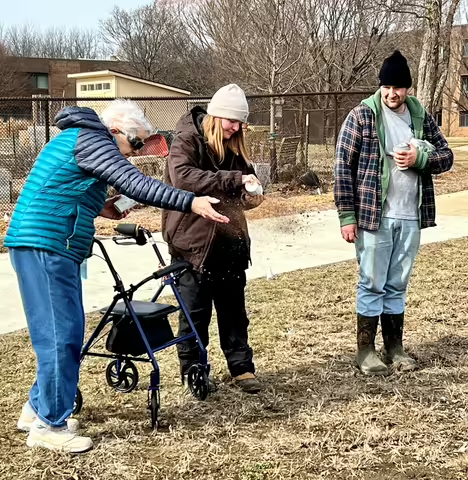On a sunny and cold day in early February, some Urbana residents helped to spread handfuls of native prairie seed on the ground. Using tools as simple as a paper cup or their bare hands, the seeds were broadcast into the air, falling silently to the ground. As these seeds are exposed to rain, sun and warming temperatures in the coming months, they will germinate and start to establish a native prairie planting filled with beautiful flowering plants and tall, stately grasses.
To a gardener, this might seem like an arbitrary way to set plants into motion. Many of us are used to carefully planting the right plant in the right location, focusing on the exact placement of individual plants in the landscape.
Spreading seeds into the air simply feels like it leaves too much to chance, making it difficult to visualize the resulting plant community. However, this type of prairie plant establishment is quite common and actually relies on chance to create a thriving and diverse plant community.
The folks hard at work spreading seeds were all members of the ClarkLindsey retirement community, situated on 27 acres adjacent to Meadowbrook Park in Urbana.
“ClarkLindsey has a history of providing innovative landscaping to its residents and to the public at large,” says Randy Hauser, who is the ClarkLindsey Landscape Designer and Horticulturist. “These new natural areas will let us go totally wild with a different kind of "gardening". We want to juxtapose these prairie endeavors with our acres of fuss-budget landscaping and show that we can provide an interesting balance of both.”
Despite Hauser’s positive message and gentle guidance, many of the residents were unsure about the unfamiliar methods. Questions like, “Am I doing this right?” and “Are you sure I’m getting enough seed spread?” were common.
Hauser would reply with encouragement, saying things like, “there is no wrong way to do this” or “you’re doing great, keep it up”. It was obvious that the Horticulturist was thrilled with the residents’ willingness to participate and was enjoying every minute of the community effort.
The seed residents spread will add to the diversity of the planting by establishing flowering forbs and many of the iconic prairie species we all think of in bloom. Hauser and his staff had plans later in the day to spread additional seed, including many of the grass species and other staples of prairie communities. They will carefully broadcast at a preplanned rate, designed to ensure the establishment of prairie plant cover across the site.
Knowing the follow-up seeding later in the day will fill in any gaps, Hauser and his staff were able to have fun with residents and encourage them to spread seed without too much worry for how or where seed was falling. It created a fun, festive environment where residents could participate as much or as little as they were able and everyone got to contribute.
“This is a great project! I love sowing seeds anyway. I love seeing the prairie flowers. I don’t know what exactly to expect to see, but just about everything will look good,” commented Clark Lindsey resident, Phyllis Brussel.
The randomness of broadcasting seed and time of year chosen all work to mimic nature, creating a thriving and natural-looking plant community. This type of planting is often referred to as “frost seeding”, as it relies on the freezing and thawing action of the upper soil layers to create good seed-to-soil contact, which is essential.
As plants emerge this spring, all will compete for space and the winners will be pretty obvious by summertime. However, it takes several years for all the planted species to emerge, compete, and become established. The next few years will be an exciting time to watch this developing plant community.
“ClarkLindsey is a very special place for a lot of reasons including the gardens and the grounds and the concern we have for nature and the natural environment in general,” comments ClarkLindsey resident, Anna Merritt. “This planting project is another example. I am looking forward to seeing all these beautiful wildflowers soon.”
Beyond adding natural beauty, the project also addresses sustainability goals by adding habitat and reducing maintenance inputs over time.
“We will take roughly two acres out of our standard mowing/fertilization/broadleaf treatment rotation. Even in its infancy, ClarkLindsey's fledgling prairie is telling a better story of land stewardship,” says Hauser.

